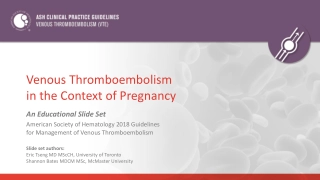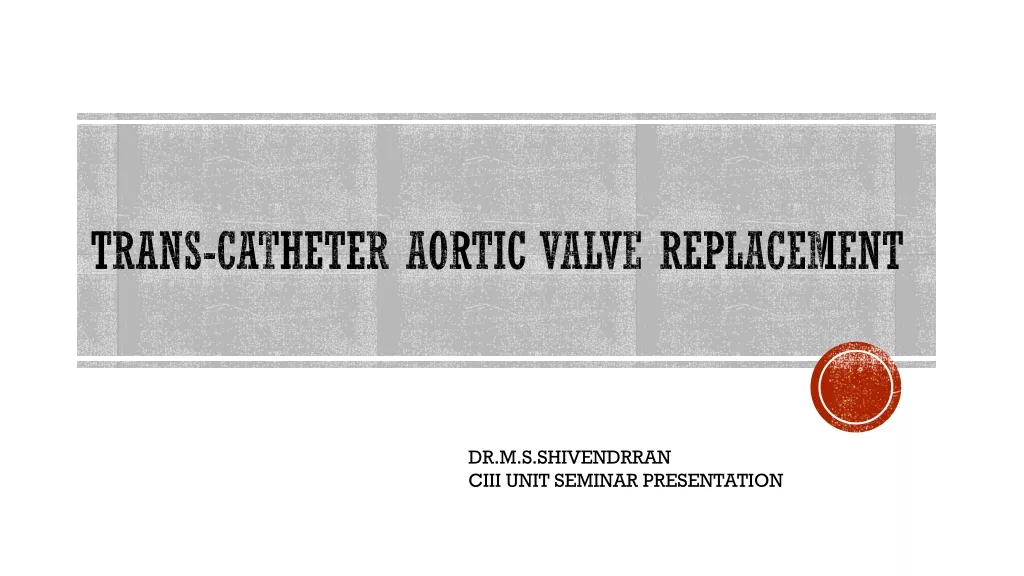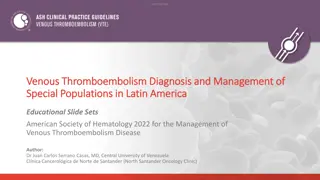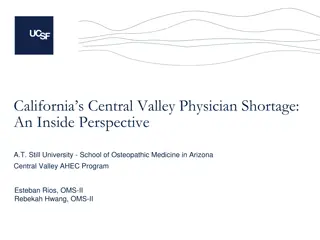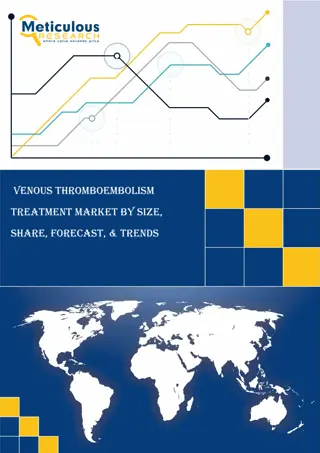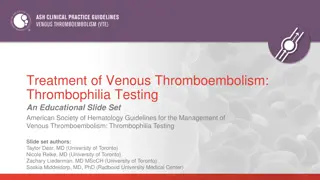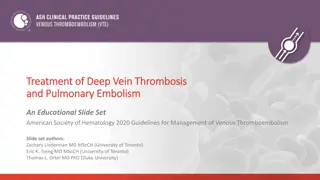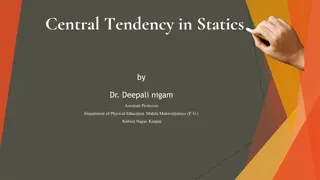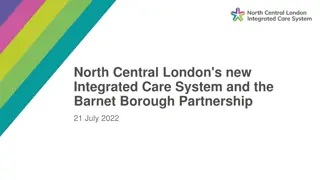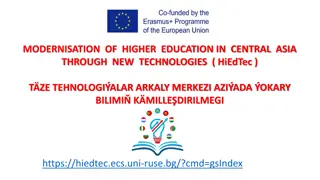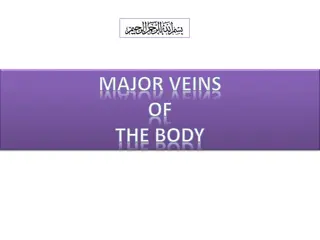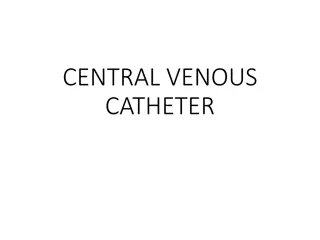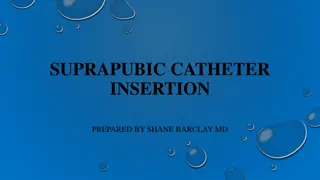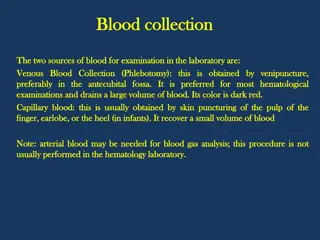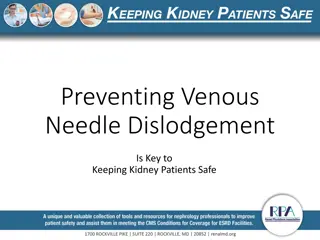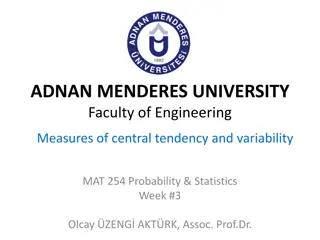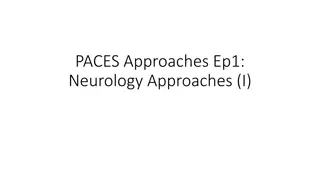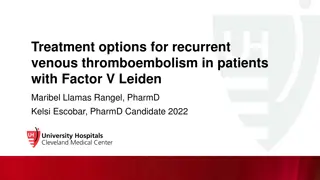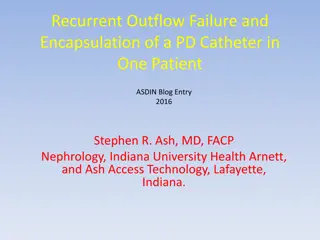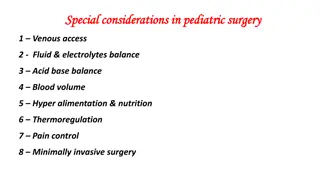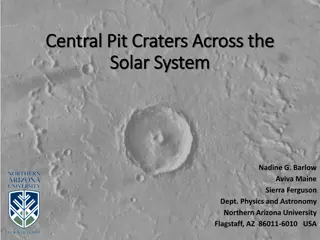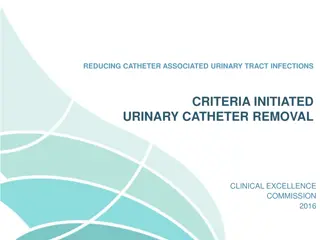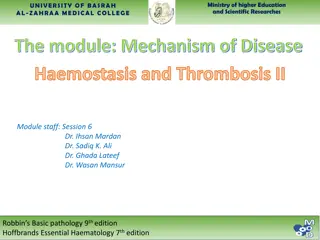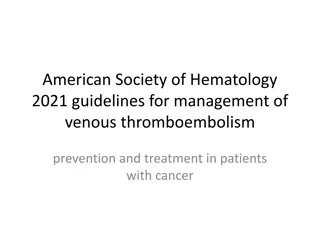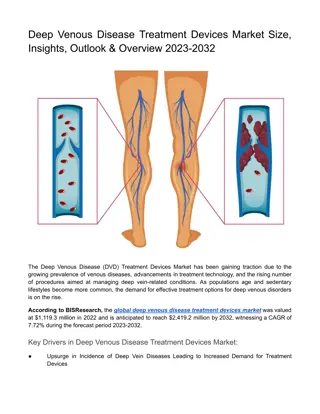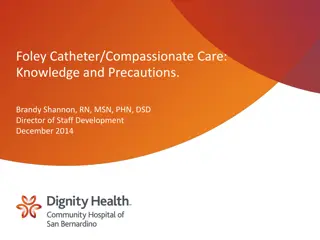Venous Thromboembolism in the Context of Pregnancy
Key guidelines from the American Society of Hematology (ASH) in 2018 focus on managing venous thromboembolism in pregnancy. The guidelines cover prevention, treatment, and optimal management of VTE in various clinical settings. Panels formed for guideline development included diverse expertise to en
1 views • 49 slides
Advances in Trans-Catheter Aortic Valve Replacement: A Comprehensive Review
This presentation explores the evolution of Trans-Catheter Aortic Valve Replacement (TAVR), highlighting historical milestones, anatomical considerations, the role of Balloon Aortic Valvuloplasty, current guidelines, the need for TAVI, and a notable case study by Dr. Cribier. The content discusses t
2 views • 85 slides
Venous Thromboembolism Diagnosis and Management in Latin America: ASH 2022 Educational Slide Sets
The American Society of Hematology (ASH) 2022 guidelines for the diagnosis and management of venous thromboembolism in special populations in Latin America are presented in educational slide sets authored by Dr. Juan Carlos Serrano Casas and other experts. The Latin American ADOLOPMENT project, a co
0 views • 52 slides
Central Venous Catheter Access Management in Brampton and Surrounding Areas
Nurse-led Outreach Team in Brampton, North Etobicoke, West Woodbridge, Malton, and Bramalea provides education on managing central venous catheter access devices like PICCs. Learn about preventing infections, post-insertion care, types of CVADs, and aseptic techniques for PICC line management.
1 views • 20 slides
Addressing Physicians Shortage in California's Central Valley
The San Joaquin Valley in California faces a severe physician shortage, with the lowest doctor-per-capita ratio in the state. To tackle this issue, efforts are being made to establish the Central Valley Medical Association, organize the first Central Valley Medical Conference, and gather insights fr
2 views • 13 slides
CBI- Central Bank of India apprentice recruitment process.
Central Bank of India (CBI) holds the distinction of being among the most established and sizable commercial banks in India. It was established in 1911. It has a significant presence in the Indian banking sector. \nTo Know more: \/\/obcrights.org\/blog\/jobs\/government-jobs\/central\/exams\/banking
9 views • 5 slides
Understanding Central Venous Line (CVL) and Central Venous Pressure (CVP) Monitoring
Central Venous Line (CVL) and Central Venous Pressure (CVP) monitoring play critical roles in intensive care settings. This article covers the indications, types, insertion sites, and contraindications of CVL. It also explains the significance of CVP measurement and how to perform and interpret it u
3 views • 40 slides
Venous Thromboembolism Market
Venous thromboembolism occurs when a blood clot forms in a vein, obstructing the blood flow and posing a potentially life-threatening risk. Several devices and drugs are employed for the prevention and treatment of venous thromboembolism. The devices considered within this scope are utilized for bot
5 views • 3 slides
Guidelines for Thrombophilia Testing in Venous Thromboembolism Management
The American Society of Hematology (ASH) provides comprehensive guidelines for the management of venous thromboembolism (VTE) with a focus on thrombophilia testing. Expert panels develop recommendations based on clinical questions, evidence synthesis, and resource use. These guidelines cover various
2 views • 47 slides
ASH Guidelines 2020: Management of Venous Thromboembolism
American Society of Hematology (ASH) released guidelines in 2020 for the management of Venous Thromboembolism, focusing on deep vein thrombosis and pulmonary embolism. These guidelines cover prevention, treatment, and optimal management strategies. The recommendations are developed through a rigorou
0 views • 45 slides
Understanding Cardiac Output and Venous Return in Cardiovascular Physiology
Cardiac output, stroke volume, end-diastolic and end-systolic volumes play vital roles in cardiovascular function. Factors affecting cardiac output include physiological conditions and pathological states like hyperthyroidism and myocardial infarction. Venous return, controlled by mechanisms like Fr
0 views • 27 slides
Understanding Measures of Central Tendency in Statistics
Measures of central tendency, such as mean, median, and mode, provide a way to find the average or central value in a statistical series. These measures help in simplifying data analysis and drawing meaningful conclusions. The arithmetic mean, median, and mode are commonly used to represent the over
0 views • 11 slides
ASH Guidelines on Venous Thromboembolism in Pregnancy
The American Society of Hematology (ASH) 2018 guidelines provide comprehensive management recommendations for venous thromboembolism in pregnancy. Key aspects include panel formation, clinical questions generation, evidence synthesis, and making recommendations. The guidelines offer strong and condi
0 views • 49 slides
Understanding the Intrinsic Muscles of the Tongue - Anatomy and Physiology Overview
In this detailed presentation by Dr. Sushma Tomar, Associate Professor of Anatomy, the intrinsic muscles of the tongue are explored, along with their functions, arterial and venous supply, lymphatic drainage, and nerve supply. The lecture covers the four intrinsic muscles in each half of the tongue,
1 views • 15 slides
North Central London Integrated Care System Overview
The North Central London Integrated Care System (ICS) is a collaborative approach to healthcare planning and delivery across five boroughs. Led by the North Central London Health and Care Partnership, the ICS aims to meet the diverse health, public health, and social care needs of the region through
0 views • 29 slides
Understanding Central and Non-Central Forces in Physics
Newton's laws of motion introduced the concept of forces, leading to the classification of fundamental forces like gravitational, electromagnetic, strong nuclear, and weak nuclear forces. Central forces act toward or away from a fixed center, while non-central forces are affected by additional param
0 views • 7 slides
Understanding Central Place Theory: Key Concepts and Determinants
Central Place Theory (CPT) attempts to explain the spatial arrangement, size, and number of settlements based on central places, zones of influence, and hinterlands. This theory, introduced by Walter Christaller in 1933, outlines the importance of central functions, threshold populations, and factor
0 views • 12 slides
Guidelines for Management of Pediatric Venous Thromboembolism
This educational slide set presents the American Society of Hematology's 2018 guidelines for the treatment of pediatric venous thromboembolism. The guidelines cover various aspects such as prevention, treatment, and optimal management of anticoagulation therapy in pediatric patients. Panels were for
0 views • 47 slides
Modernisation of Higher Education in Central Asia Through New Technologies (HiEdTec)
This project focuses on the modernization of higher education in Central Asia using new technologies. It includes themes like ionization, piezoelectricity, and ultrasonic devices. The initiative aims to enhance learning experiences and teaching methodologies in the region. Various educational instit
3 views • 26 slides
Overview of Veins and Venous Circulation in the Body
Veins play a crucial role in the circulatory system by carrying deoxygenated blood back to the heart. This lecture covers the general principles of veins, the anatomy of major veins like the superior and inferior vena cavae, tributaries, and their roles in different parts of the body. It also discus
0 views • 14 slides
Central Venous Catheters: Uses, Placement, and Indications
A central venous catheter (CVC) is a crucial medical device placed into a large vein for various purposes like administering medication, fluids, and obtaining blood tests. The catheter can be tunneled or non-tunneled, and specific sites are preferred for each type. Indications for CVC usage include
1 views • 19 slides
Pediatric Vascular Access Techniques and Considerations
This article discusses various vascular access methods in infants and children, including peripheral IV access, central venous access, arterial lines, and ultrasound-guided techniques. It covers indications, sites, complications, and techniques for each method, emphasizing the importance of proper a
1 views • 56 slides
Suprapubic Catheter Insertion Procedure Guidelines
Suprapubic catheter insertion is a procedure indicated for conditions such as urethral injury, obstruction, bladder neck masses, and benign prostatic hypertrophy. It involves proper patient positioning, analgesia, equipment preparation, and a step-by-step technique including bladder palpation, marki
1 views • 12 slides
If you are looking for Ramen in West Central Westminster
If you are looking for Ramen in West Central Westminster, Authentic Japanese Dining at Tokyo House in North Central Westminster. Welcome to Tokyo House, your premier Japanese restaurant in North Central Westminster. We offer an authentic dining exper
0 views • 6 slides
Venous Blood Collection Methods and Equipment Overview
Venous blood collection techniques, including antecubital fossa and heel sticks, are commonly used for laboratory examinations. Venous blood is preferred for its large volume and ease of recovery. This article also explores the differences between capillary and venous blood samples in terms of compo
0 views • 8 slides
Dynamics Business Central Training in Ameerpet | D365 Business Central Training
Visualpath offers the Best Dynamics Business Central online training course by real-time experts for hands-on learning. \nJoin us on WhatsApp: \/\/ \/catalog\/919989971070\/\nVisit: \/\/visualpath.in\/microsoft-dynamics-365-business-central-training.
0 views • 15 slides
Understanding Venous Needle Dislodgement in Dialysis Patients
Venous Needle Dislodgement (VND) is a serious complication of hemodialysis that can lead to significant blood loss and even mortality. It occurs when the venous fistula needle becomes dislocated, resulting in blood loss ranging from minor to fatal. The risk factors, consequences, and frequency of VN
0 views • 30 slides
Overview of Central Tendency Measures in Statistics
A measure of central tendency in statistics aims to describe a dataset by identifying its central position. This includes commonly used statistics like the mean. This article covers various aspects of central tendency measures, including data types, sampling techniques, graphical methods, and more.
0 views • 23 slides
Approach to Headache and Neurological Symptoms in Clinical Practice
Comprehensive overview of primary and secondary headaches, red flags, and patterns in neurological presentations. Discusses distinguishing features, differential diagnoses, and management approaches for various conditions affecting the central and peripheral nervous system. Highlights important cond
0 views • 16 slides
Treatment Strategies for Recurrent Venous Thromboembolism in Factor V Leiden Patients
This presentation discusses the treatment options for recurrent venous thromboembolism in patients with Factor V Leiden mutation. It explores the pathophysiology, epidemiology, and diagnosis criteria for Factor V Leiden, reviews failed anticoagulation history, and suggests outpatient anticoagulation
0 views • 31 slides
Case Study: Recurrent Outflow Failure and Catheter Encapsulation in PD Patient
Case study of a 69-year-old patient with hypertensive nephrosclerosis experiencing recurrent outflow failure and encapsulation of a PD catheter. Initial difficulties with catheter placement led to multiple instances of pain on inflow/outflow, necessitating repositioning and replacement procedures. E
0 views • 10 slides
Pediatric Surgery: Special Considerations for Venous Access and Fluid Management
Pediatric surgery requires special attention to venous access and fluid management due to unique considerations in infants and children. Key aspects include methods for obtaining vascular access, monitoring fluid and electrolyte balance, and addressing specific fluid requirements based on age and we
0 views • 15 slides
Central Pit Craters Across the Solar System - Comparative Study
Study led by Nadine G. Barlow and team from Northern Arizona University investigates central pit craters on various celestial bodies. Central pit craters are unique crater formations with central depressions, seen on Mars, Ganymede, Callisto, and more. The project aims to compare these craters on di
0 views • 11 slides
Strategies for Preventing Catheter-Associated Urinary Tract Infections
Catheter-associated urinary tract infections are a common healthcare-associated infection, with 80% of hospitalized patients experiencing a urinary tract infection. This article provides guidelines for preventing CAUTIs, such as only catheterizing patients when necessary, maintaining asepsis, practi
0 views • 20 slides
Understanding Embolism and Venous Thrombosis in Mechanism of Disease
Embolism, defined as a detached intravascular mass carried through the blood, poses serious risks like pulmonary embolism. Venous thrombosis, particularly deep vein thrombosis (DVT), can lead to embolization, emphasizing the importance of understanding these mechanisms in medical practice.
0 views • 40 slides
American Society of Hematology 2021 Guidelines for Venous Thromboembolism in Cancer Patients
The American Society of Hematology (ASH) 2021 guidelines provide recommendations for preventing and treating venous thromboembolism (VTE) in cancer patients. The guidelines cover primary prophylaxis for hospitalized medical patients and those undergoing surgery, emphasizing the use of thromboprophyl
0 views • 23 slides
Preventing Catheter-Associated Urinary Tract Infections
This presentation covers the prevention of catheter-associated urinary tract infections (CAUTIs) in healthcare settings. It highlights the significance of urinary tract infections, risk factors, preventive measures, and common microbiology involved. Key topics include the importance of urine collect
0 views • 34 slides
Deep Venous Disease Treatment Devices Market
The global deep venous disease treatment devices market was valued at $1,119.3 million in 2022 and is anticipated to reach $2,419.2 million by 2032, witnessing a CAGR of 7.72% during the forecast period 2023-2032.\n\nRead Report Overview: \/\/bisrese
1 views • 3 slides
Foley Catheter Care and Compassionate Practices
Providing guidance on the compassionate care and proper maintenance of Foley catheters is essential for healthcare staff. This presentation covers the identification of urinary tract infection symptoms, methods for maintaining catheter integrity, and ensuring patient comfort during turning and trans
0 views • 14 slides
Managing Catheter-Related Bloodstream Infections in Vascular Access
Reduce and prevent catheter-related bloodstream infections in vascular access by addressing extraluminal infection sources and implementing strategies outlined in national drivers such as the NHS Long Term Plan and the Antimicrobial Resistance Action Plan. Recognize the importance of tackling antimi
0 views • 25 slides
